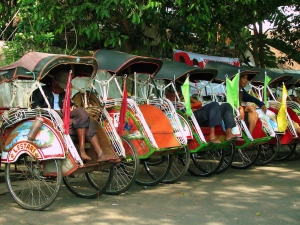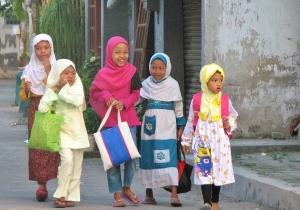Traveling to Java was not in our plans for this trip. But now that we’d let go of breaking bread with the Borneo headhunters, we were excited to be seeing another island of Indonesia. (By the way, there are no longer headhunters in Indonesia, so we’re told).
The island of Java lies close to Bali’s western edge. It is where the original Hindu artists and royalty fled from a thousand years ago, to Bali, to escape a wave of Islamic rule. The capital of Jakarta sits at the far end. There aren’t many cities that I have no interest in seeing, but Jakarta is one. Virtually everything we hear or read about it describes it as unlivable now -though several million people do just that. However, in the middle of this large, oblong island is Yogyakarta (“Joeg jakarta” or “Joeg ja”). It is the cultural and artistic center of Java, if not all of Indonesia, and we’d heard many good things about it.
As our airport taxi wound its way through it towards our hotel room, our first impression was: big city. Somehow I keep imaging narrow dirt roads, tropical breezes, and lots of hammocks at these new destinations (that even Ubud didn’t live up to that ideal should’ve put an end to such projections). A ring road encircles most of Yogya, several kilometers across. Inside the circle lies a spaghetti bowl of roads, sprinkled with a grid of busy, wide thoroughfares. There’s a lot of traffic, including motorbikes, trishaws, and horse-drawn carriages, moving at a constant and quick pace.
At first glance, Yogya looks flat. But there are several rivers running through it, that sink down and out of sight, hidden behind the street’s buildings. Entire neighborhoods line these urban rivers, largely removed from the street chaos nearby. Crude cement bridges cross from one side to the other. Men and boys dangle their feet over the cement sides, bamboo poles in hand. Back up along the foot path, large boxes of river water contain their catch.
It took us a couple of days to like Yogya. We had immediately taken to our neighborhood, a backpackers street and area located in the southern region. Lots of trishaws, and cafes. The international eco-cafe/store, Via Via was nearby. And Milas, with its food, outreach program, and local market felt great to support. And the bookstore Satu Dunia (One World) offered lots of books, info, and a motorbike to rent. We used it first to get a lay of the land, and headed south, out of the city to a region called Bantul. Much less urban, we criss-crossed a wide area, exploring small villages and country roads for hours -one of my favorite things to do. We got happily lost, and passed through small charming villages known for their pottery. We passed many mosques, food markets, and vast expanses of beautiful rice fields that resembled Bali.
We began to appreciate the variety of life here. Take any small road and it will surprise you. There are countless maze-like neighborhoods. Some seemed almost Middle-Eastern. Narrow paths branched off to even narrower ones, and again, and again. Old people sat still on their stoops while small children ran around. Drying clothes dangled everywhere. The Sultan’s Palace is an enormous, flat, white-walled compound, with public streets running all through it, and with a tunneled entrance/exit out each of the 4 directions. The Sultan still lives there -and employs 1,000 workers. It’s a city within a city, easy (and fun) to get lost in. We enjoyed people-watching at its large, dirt square. Trishaw drivers and food stalls line its ring road. In the middle are two large banyan trees, surrounded by bubble-makers, kite-flyers, and families loitering about.
Elsewhere around town, we found an enormous bird market. Scores of stalls displayed hundreds of beautiful dangling cages, with thousands of the most beautiful birds. Brightly colored or subtly delicate, most of them whistled and chirped. I appreciated their beauty, but few things sadden me more than caged animals, especially birds. We didn’t stay long, and exited past a section of over-crowded fish tanks.
Yogya is an artsy town. We loved the ubiquitous graffiti, often beauiful or clever, and surprisingly thoughtful and political. It is also the center for puppet-making, batik, and dance performance. One day we met a woman who invited us back the next night to watch her dance troup rehearse. We were the lone foreigners there, and found the performances beautiful.
This was an exciting time to be in Java. The city was filled with references to the important, upcoming Presidential election. We were surprised that one of the candidate’s posters (the eventual loser) promoted his ties to Hezbollah. (And we learned that Israeli nationals are not allowed into Malaysia). It was Ramadan too, so there were plenty of Calls to Prayer throughout the days and nights, and, the Muslim restaurants were closed every day until nightfall. We felt that the food in Java was both tastier and cheaper than in Bali. There were two other comparisons that we made between Java and Bali. Firstly, the later is a tourist island, and so much of the interactions are between tourists and service personnel who depend on tourism, and there’s an unspoken tension that is created. In Java, we felt no such thing. It’s not a tourist destination, so we felt more comfortable and able to just blend in. Secondly, Yogya is interesting and has it’s charms, and we both felt that we could live there (we visited 3 of their well-known language schools as we kicked ideas around) but it is not an especially pretty city. It helped to remind us that Bali is beautiful.
There are many sights to see in or near Yogyakarta. The most famous is Borobudur, the world’s largest Buddhist temple, about an hour north of the city. Built in the 9th century, it’s an amazing, enormous, pyramidal-like monument made of grey stone. It has many levels to explore, each with hundreds of relief panels and carved buddhas. At the top, situated around a main dome, are 72 more Buddha statues each seated inside a perforated stupa (bell shape). And, Borobudur is surrounded by beautiful mountains and lush green trees and vast lawns on all sides.
The second most popular temple in Yogya is Prambanan, which we saw on our way to the airport. It’s the largest Hindu temple site in Indonesia, and a UNESCO World Heritage Site. One towering, tall and pointed grey stone temple is surrounded by several shorter ones, each with scores of relief carvings and steps that climb up inside to reveal varied statues standing inside the darkened rooms. These temples were once surrounded by 224 smaller temples arranged in concentric square rows, now mostly reduced to piles of stones. Prambanan was greatly damaged by a strong earthquake that rocked Java in 2006, and is still being restored.
I continue to be amazed and astounded by the lengths human beings have gone to show reverence for their God(s). The sheer man-years involved. The sacrifices. The humility. The stones we’ve moved and carved. The temples we’ve designed and built -somehow, so long ago.
-matt




















Aug 01, 2014 @ 16:15:30
Wow . . . those temples look amazing! There is a fun serendipity to travel, where some destinations you have been looking forward to can sometimes fall flat, but then other destinations for which you had low expectations can be unexpectedly delightful. Happy travels!
Aug 01, 2014 @ 18:03:56
Good to hear from you all!
Aug 01, 2014 @ 20:59:50
Love the photos you both look so relaxed and content 🙂